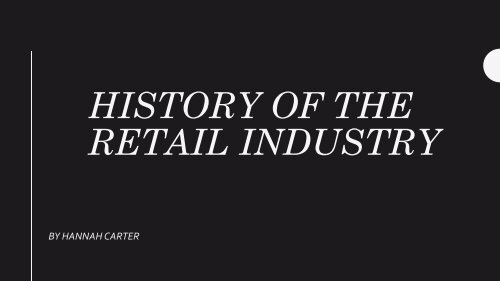retail history time line
You also want an ePaper? Increase the reach of your titles
YUMPU automatically turns print PDFs into web optimized ePapers that Google loves.
HISTORY OF THE<br />
RETAIL INDUSTRY<br />
BY HANNAH CARTER
Change in<br />
store types<br />
Market stalls<br />
Shop keeper stalls with credit<br />
spending for the wealthy<br />
Individual stores e.g. bakery,<br />
grocery<br />
Department Stores<br />
Supermarket<br />
In town shopping centre<br />
Out of town shopping centre
Industrial<br />
revolution<br />
First cash<br />
tills were<br />
invented<br />
World war 1<br />
Great<br />
depression World War 2<br />
Bullring –<br />
first in town<br />
shopping<br />
centre<br />
First Argos<br />
catalogue<br />
was<br />
released<br />
1883<br />
1900<br />
1914 1918 1929 1939<br />
1945<br />
1964<br />
1973<br />
1880<br />
1948<br />
1966<br />
1980<br />
Lighting was<br />
developed<br />
which helped<br />
to develop<br />
factories.<br />
First coop<br />
launched<br />
First Super<br />
Store – Gem<br />
changed to<br />
ASDA West<br />
Bridgford in<br />
1966.<br />
Burton and<br />
Chelsea girl<br />
became<br />
stand alone<br />
gender<br />
brands.
History of the<br />
<strong>retail</strong><br />
industry<br />
1880-1970s<br />
• The industrial revolution between the 1870s and 1900<br />
which caused a lot of change when many methods of<br />
hand production were transitioned to machinery. This<br />
transition occurred in 1760 to the mid 1800s and therefore<br />
impacted the late 1800s and early 1900s with the extreme<br />
change as <strong>retail</strong>ers were supplied with useful equiment in<br />
order to make their jobs and lives easier. The invention of<br />
machinery and lighting also helped to develop and<br />
increase the mass production of cheaper products.<br />
• London Co-operative Society opened its first self-service<br />
shop in 1948, known to us today as the co-op.<br />
• The Bullring in Birmingham was the first in town shopping<br />
centre in England to open in 1964 where locals would go<br />
for days out shopping for the whole shopping experience,<br />
it hasn’t changed much since then as people go for days<br />
out to different cities so they can visit different shops and<br />
have a different shopping experience.
1880 – 1970…<br />
• Also in 1964 the first superstore opened in West Bridgford<br />
then called Gem and two years later, in 1966 reopened as<br />
ASDA as it remains to this day. The superstore was the step<br />
up from a supermarket.<br />
• Cars were becoming more of common around the 1950s –<br />
70s, this is when out of town shopping centers were being<br />
built with car parks so that they were more accessible to all<br />
consumers.<br />
• The first Argos catalogue was released in 1973 which<br />
introduced catalogue buying from department stores.<br />
• In the 80s Burton and Chelsea Girl became standalone high<br />
fashion brands which gives a great example of <strong>retail</strong><br />
development, where gender roles were becoming more<br />
prominent.
Contemporary <strong>retail</strong> concepts<br />
Increase in the<br />
popularity of<br />
Pop Up Stores<br />
Mail order<br />
World Wide<br />
Web was<br />
invented<br />
Sunday<br />
trading<br />
On<strong>line</strong><br />
shopping<br />
Geo<br />
location<br />
marketing<br />
Virtual<br />
mirrors<br />
1980 1986 1990 1994 2000<br />
Omni channel<br />
marketing<br />
2014<br />
Drip campaigns<br />
made an<br />
appearance on<br />
our computer<br />
screens<br />
Email<br />
receipts
The <strong>retail</strong><br />
industry<br />
from 1980<br />
to present<br />
• In the 1980s mail order was used to order products through<br />
catalogues and over the phone, referencing the goods from a<br />
directory. However even at this point in the 80s, mail order<br />
was becoming an on<strong>line</strong> task and has now over taken any<br />
catalogues or directories.<br />
• Drip campaigns, that observe your on<strong>line</strong> behavior urge<br />
adverts to pop up on any website in order to catch your<br />
attention and entice you to buy the products – this is a recent<br />
method of advertisement that has emerged in the 2010’s.<br />
• Many companies will take your e-mail over the internet when<br />
you subscribe to a website store and send emails like… ‘we<br />
miss you’ if you haven’t visited in a while – to make the<br />
company come across personable.
1980 – present The Bricks and Mortar way of <strong>retail</strong> has no offers or deal no<br />
advertisement – an example of a <strong>retail</strong>er that use this method is<br />
Burberry who rely solely on footfall, their high investment décor<br />
creates the atmosphere where passers-by are intrigued.<br />
Currently on<strong>line</strong> and off<strong>line</strong> are becoming blurred because<br />
nearly all methods of <strong>retail</strong> are shifting on<strong>line</strong> and in nearly<br />
every <strong>retail</strong>er they will ask for an email to send your receipt to,<br />
this has started in the 2000s.<br />
http://www.visual<strong>retail</strong>ing.com/blog/2016/10/from-brandexperiences-to-product-launches-how-pop-up-stores-arerevitalising-brick-mortar-<strong>retail</strong><br />
http://www.globaltoynews.com/2016/04/pop-up-stores-thenew-face-of-<strong>retail</strong>.html
Contemporary<br />
Retail<br />
Concepts and<br />
New<br />
Technology<br />
Innovation and technological development have led to exciting new<br />
material products and finishes. So much so that we are starting to see<br />
the rise of ‘fake authentic’ – materials that are technically fake,<br />
however their visual appeal and operational benefits are actually<br />
better than the real thing. As a result, it may be that the flooring is<br />
specified to be a ceramic wooden-effect tile as opposed to a real<br />
wooded floor finish. And with the <strong>retail</strong> realities of cleaning and<br />
durability, it will do a better job for the life of the store. We don’t need<br />
high-quality, durable materials that will last for the next six to 10 years<br />
when the store may get fully rebuilt in the next three to four years.<br />
http://www.visual<strong>retail</strong>ing.com/blog/2016/10/from-brand-experiences-toproduct-launches-how-pop-up-stores-are-revitalising-brick-mortar-<strong>retail</strong><br />
Customer service is an authentic concept which always and these<br />
actions always work, a consumer will return to a store if their<br />
experience was relaxing they are polite kind good service.<br />
Omnichannel is about seamless technology and interacting with<br />
everything Omni channel marketing is similar to geo location<br />
marketing where – consumers can receive emails from stores that<br />
have their details and just generally be very connected with all the<br />
goings on.<br />
Multi channelling in marketing – finding different ways to interact<br />
with their consumers for example loyalty cards and apps where<br />
customers are much more likely to visit a store.
Contemporary<br />
Retail<br />
Concepts and<br />
New<br />
Technology<br />
Virtual mirrors are an up and coming shopping ‘device’ to<br />
save <strong>time</strong> and effort for customers, it is always being<br />
developed so that in the future they are fit for use in all<br />
<strong>retail</strong>ers.<br />
Pop up stores have become increasingly common as brands<br />
and <strong>retail</strong>ers look to create new ways to heighten the brick<br />
and mortar arm of their operations. A temporary storefront -<br />
usually created for a specific purpose - pop ups are now being<br />
used by not only niche brands and <strong>retail</strong>ers, but the likes of<br />
Adidas, Ralph Lauren, H&M, and many more. The unusual<br />
exterior of these stores are attractive to the foot fall, they<br />
almost reflect a market stall therefore their clientele are<br />
more inc<strong>line</strong>d to visit these shops just for something<br />
different<br />
Personal shopping is a contemporary <strong>retail</strong> concept that is<br />
being introduced to department stores.<br />
Retailers have cleverly created loyalty cards in order to build<br />
customer relationships – that will provide offers and<br />
discounts after using it multiple <strong>time</strong>s.









